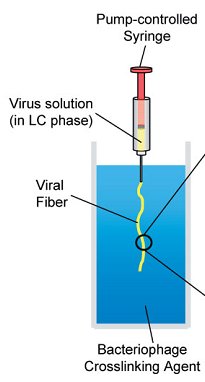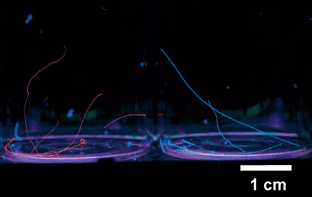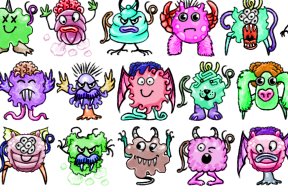A while back (since I’m extremely slow on posting things), PZ Myers had an interesting post on a mutation that can turn fruit flies bisexual. Commenter Apikoros pointed to an even more interesting (i.e. has pretty pictures) paper about another mutation that turns male flies gay. Given the series of insect mating posts on here, I had to take a look. First a bit about the genetics. Fruit flies have a white gene which codes for pigment production (white [an absence of pigments] being the trait that is expressed in flies when the mutation is present). The gene is made of 2600 base pairs (the rungs of the DNA helix ladder) on the X chromosome coding for a protien made up of 687 amino acids. Interestingly, the protien is 58% similar to a related protien found in humans.
Scientists are often trying to insert new or modified genes into fruit flies. It’s usually difficult to tell if their gene has been successfully inserted so researchers add their gene next to an obvious marker gene. White vs. pigmented flies provide a good marker so scientists created an artificial white imitator gene called mini-white. Scientists stick the desired gene and the mini-white gene together and then insert them into white fly embryos. Any flies that grow up with dark eyes should also have the test gene. To allow even further control, scientists attach DNA that acts as a heat activated switch to the control gene. They can then turn on their target gene whenever they want by heating up the flies.
Now being able to flip a switch in an animals genetics is already pretty cool but now we get to the interesting part. Unknown to scientists, the heat activated switch activates genes on both sides of it. This means that after heating both the target gene and mini-white suddenly flood into the fly. This influx of mini-white produces some rather odd effects. To quote from Zhang and Odenwald, the scientists that noticed this:
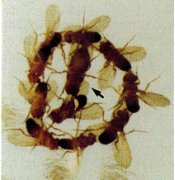
[After heating], transformant males displayed their wings in a spread outward and upward position. Close examination of these males revealed that many had protracted phalli. … Coincident with the extended-wings posture was the onset of vigorous male-male courtship.
The picture to the right shows some of this courtship. The arrow points to a poor ignored female. Again I think the researchers describe the courtship best:
Chain leaders frequently courted members of their own chains, creating courtship circles and lariats. The male-male courtship activities included touching partners with forelegs, unilateral 90° wing extensions (a display that was followed by the extended-wings posture), licking the partner’s genitalia, and curling the abdomen to achieve genital-genital contact. While participants repeated their courtship routines multiple times, no repelling signals were detected-i.e., wing flicking or face kicking.
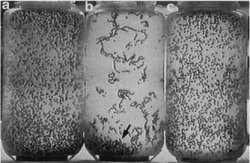
Since this was a pretty odd phenomenon, Zhang and Odenwald decided to investigate a bit further. As shown in the picture to the left, they looked at heated normal flies (left), heated mini-white flies (middle) and non-heated mini-white flies (right). Only the heated mini-white flies form the conspicious homosexual chains (the arrow points to females hiding in the corner). To test for pheremones, they tried pumping air from the homosexual bottles to the non-homosexual bottles and switching bottles but nothing happened. Interestingly, they found that even non-modified males would eventually join in the homosexual activities if most males (> 80%) in the bottle were participating mini-white flies. But that was likely a behavioral side effect and didn’t really help explain what was going on. They tried adding or removing different target genes to the mini-white and heat switch DNA but that did not change the results. They tested the children of homosexual flies and found that the homosexual trait associated with whichever chromosome had the inserted mini-white gene. They even fed mutagen to mini-white flies that altered the DNA sequence of mini-white and found that these broken mini-white flies did not exhibit homosexuality. So they are pretty sure they know that abnormal production of min-white can trigger homosexual behavior.
But they are unsure why a pigment producing protien could have such obvious behavioral effects. Interestingly, white protien is also important in transporting trytophan (yes the Thanksgiving turkey sleepiness protien [although that’s mostly a myth]). A decrease in tryptophan has been observed to cause male-male mounting in rats and rabbits. In addition, serotonin (a product of trytophan) depleted cats also exhibit homosexual behavior. This led Zhang and Odenwald to hypothesize that abnormal influx of white gene expression was causing a depletion of tryptophan and serotonin and leading to homosexual behavior although this still needs further investigation.
So this was a pretty cool and obvious demonstration of how genes, molecular pathways and behaviors are tied together both in a single animal and over quite different species (and how can you not like a paper describing “courtship chains and lariats”).
References
S.-D. Zhang & W. F. Odenwald 1995. Misexpression of the White (w) Gene Triggers Male-Male Courtship in Drosophila. Proceedings of the National Academy of Sciences 92:5525-5529

